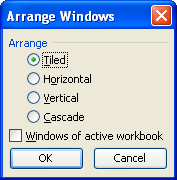Please Note: This article is written for users of the following Microsoft Excel versions: 97, 2000, 2002, and 2003. If you are using a later version (Excel 2007 or later), this tip may not work for you. For a version of this tip written specifically for later versions of Excel, click here: Arranging Workbook Windows.
Written by Allen Wyatt (last updated January 28, 2023)
This tip applies to Excel 97, 2000, 2002, and 2003
If you have more than one workbook open at a time, Excel allows you to view all the workbooks at the same time, and to arrange each window as you desire. The easiest method of arranging workbook windows is as follows:

Figure 1. The Arrange Windows dialog box.
ExcelTips is your source for cost-effective Microsoft Excel training. This tip (2738) applies to Microsoft Excel 97, 2000, 2002, and 2003. You can find a version of this tip for the ribbon interface of Excel (Excel 2007 and later) here: Arranging Workbook Windows.

Professional Development Guidance! Four world-class developers offer start-to-finish guidance for building powerful, robust, and secure applications with Excel. The authors show how to consistently make the right design decisions and make the most of Excel's powerful features. Check out Professional Excel Development today!
One of the many pieces of information that Excel keeps track of is your name. If you want to change your name for Excel's ...
Discover MoreIt's easy to select non-contiguous ranges using the mouse, but may seem more daunting if you are simply using the ...
Discover MoreNeed to clear out a large amount of information saved on the Clipboard? All you need to do is to replace it with a small ...
Discover MoreFREE SERVICE: Get tips like this every week in ExcelTips, a free productivity newsletter. Enter your address and click "Subscribe."
There are currently no comments for this tip. (Be the first to leave your comment—just use the simple form above!)
Got a version of Excel that uses the menu interface (Excel 97, Excel 2000, Excel 2002, or Excel 2003)? This site is for you! If you use a later version of Excel, visit our ExcelTips site focusing on the ribbon interface.
FREE SERVICE: Get tips like this every week in ExcelTips, a free productivity newsletter. Enter your address and click "Subscribe."
Copyright © 2026 Sharon Parq Associates, Inc.
Comments